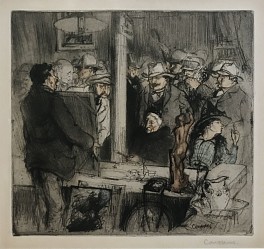BIOGRAPHY

1881-1935
ARMAND COUSSENS
(1881-1935)
The Provençal painter and printmaker Armand Coussens was born in Saint-Ambroix (Gard) in 1881. He studied at the Beaux-Arts, Nîmes, under Alexis Lahaye. Ambitious for his talented student, Lahaye encouraged Coussens to go to Paris to enter for the Prix de Rome. But the 7 years he spent in Paris from 1900 to 1907 were frustrating for the young artist, who spent his time studying the Impressionists and painting on the quais of the Seine, rather than following the stultifying course at the Beaux-Arts, Paris, which even at that date was still focussed on copying antique casts and intended to produce a new generation of history painters. Driven to despair by this academic approach, Coussens returned to Nîmes, to become professor of drawing at the Beaux-Arts there.
The nineteenth-century poet Thomas Hood, who trained as an engraver, wrote that etching "begins in a scratching and ends in a biting!" In this vividly expressive etching, Armand Coussens was certainly biting the hand that fed him. In the spirit of Daumier, it satirizes the very men on whom printmakers relied for their patronage, the "amateurs d'estampes". For such connoisseurs, print-collecting was a kind of competitive sport, in which refinement of taste was often tinged with snobbery and one-upmanship. Coussens, who began etching in 1912, had his first success in 1914 when he sold a plate to the master printer Vernant for a society of just such amateurs d'estampes. In 1919 the Musée du Luxembourg - where Coussens had spent so many days studying the Impressionist masters - bought eight etchings and a painting, as well as two watercolours by his wife, Jeanne Coussens, who had also studied under Alexis Lahaye. But this seems to have been the highwater mark of Coussens' career, and a sense of personal disappointment may lie behind the scratching and biting exhibited in Amateurs d'estampes. Although this etching and aquatint is in black only, Armand Coussens was an enthusiastic promoter of colour etchings, which were still regarded as inferior to black-and-white, despite the achievements of artists such as Raffaëlli in the previous generation. He died in Nîmes in 1935.
(From: adventuresintheprinttradeblogspot.com)
